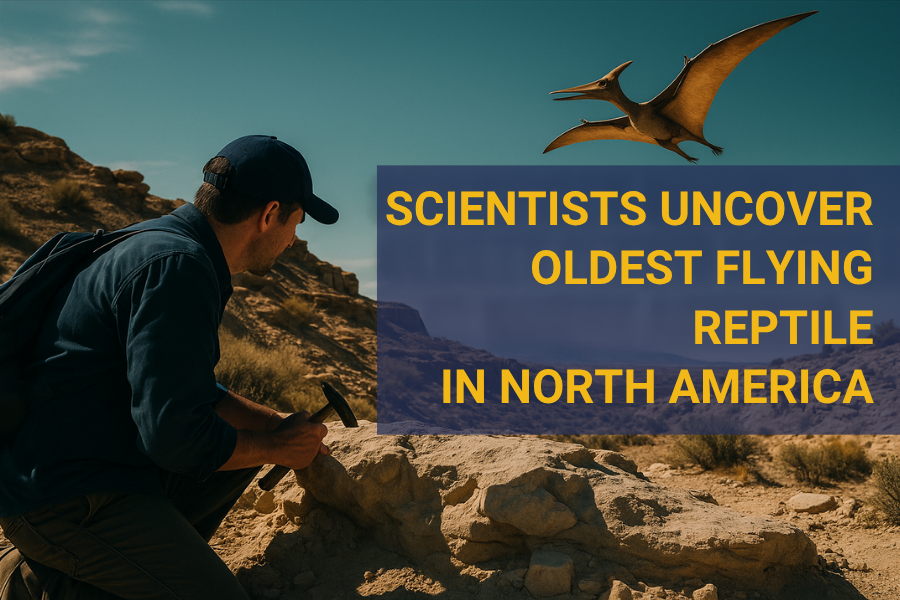Scientists Uncover Oldest Flying Reptile in North America
Intermediate | July 17, 2025
✨ 혼자서 기사를 소리 내어 읽거나 튜터를 따라 각 단락을 반복해서 읽으세요. 레벨...
Prehistoric Flying Reptile Found
The Discovery and Its Name
Paleontologists have recently announced an incredible discovery: a new species of pterosaur, a flying reptile that lived about 209 million years ago. This ancient creature, named Eotephradactylus mcintireae, is now the oldest known pterosaur found in North America. The name translates to “ash-winged dawn goddess,” honoring Suzanne McIntire, a Smithsonian volunteer who found its jawbone in 2011, and referring to the volcanic ash that helped preserve the fossil.
Where It Was Found
Researchers discovered this significant find at Petrified Forest National Park in Arizona, USA. Volcanic ash in an ancient riverbed preserved the fossilized remains, including a jawbone with teeth and bones from the creature’s long, wing-forming fingers. Scientists recognize that pterosaur bones are very fragile, which makes it especially exciting to uncover such a complete specimen from the Triassic era.
Meet Eotephradactylus mcintireae
Size and Features
Imagine a creature about the size of a small seagull, small enough to sit on your shoulder. That’s how big Eotephradactylus mcintireae was! Its wingspan measured about one meter (three feet), and its skull was roughly 10 cm (four inches) long. This pterosaur had curved fangs designed for catching fish and sharp, blade-like teeth for slicing its prey. Scientists believe it likely ate primitive fish with tough, armored scales, based on how worn its teeth were.
A Snapshot of Pre-Extinction Life
This discovery is important because it helps fill a gap in the fossil record just before a major extinction event at the end of the Triassic period. It provides a unique look into a transitional ecosystem where older animal groups lived alongside newer ones, like early frogs, turtles, and pterosaurs. The site where the Eotephradactylus mcintireae was found also contained fossils of at least 16 other vertebrate species, with seven of these being entirely new to science.
What Scientists Learned
The research team, led by paleontologist Ben Kligman from the Smithsonian’s National Museum of Natural History, published their findings in the Proceedings of the National Academy of Sciences. This amazing fossil helps us understand more about how terrestrial vertebrate communities developed and changed over millions of years, offering a true snapshot of an ancient tropical environment.
Vocabulary
- Pterosaur (noun): An extinct flying reptile of the Triassic, Jurassic, and Cretaceous periods, with a long, tooth-filled beak and a large membranous wing supported by an elongated fourth finger.
- Example: “The pterosaur soared high above the ancient forests.”
- Discovery (noun): The act of finding something for the first time.
- Example: “The archaeological team announced a major discovery of ancient pottery.”
- Fossil (noun): The remains or impression of a prehistoric plant or animal embedded in rock and preserved in petrified form.
- Example: “They found a perfectly preserved fossil of a fern leaf.”
- Jawbone (noun): The bone of the jaw, especially the lower jaw.
- Example: “The paleontologist carefully examined the jawbone of the ancient animal.”
- Preserved (verb): Kept in its original state or in good condition.
- Example: “They found that the ancient city was remarkably preserved under layers of ash.”
- Paleontologist (noun): A scientist who studies fossils to learn about the history of life on Earth.
- Example: “The paleontologist spent years digging for dinosaur bones.”
- Transitional (adjective): Relating to or characteristic of a process or period of change.
- Example: “The company is in a transitional phase, moving to new leadership.”
- Ecosystem (noun): A biological community of interacting organisms and their physical environment.
- Example: “Protecting the rainforest is crucial for the health of its delicate ecosystem.”
- Fangs (noun): A long, pointed tooth, especially a canine tooth of a carnivorous animal.
- Example: “The snake bared its fangs when it felt threatened.”
- Extinction (noun): The state or process of a species, family, or other group of animals or plants becoming extinct.
- Example: “Climate change is accelerating the rate of species extinction.”
Discussion Questions (About the Article)
- What is the name of the new pterosaur species and what does its name mean?
- Where was the fossil discovered, and why is that location significant?
- What made this particular pterosaur find so rare?
- Describe the estimated size and some key features of Eotephradactylus mcintireae.
- How does this discovery help scientists understand the late Triassic period?
Discussion Questions (About the Topic)
- Why do you think it’s important to study ancient animals and ecosystems?
- What challenges do you think paleontologists face when looking for fossils?
- If you could discover any ancient creature, what would it be and why?
- How do you think technology helps modern paleontologists in their work?
- What are some other famous fossil discoveries that you know about?
Related Idiom
A walk in the park
- Meaning: Something that is very easy to do.
- Example: “Finding this rare fossil was not a walk in the park; it took years of dedicated searching and digging.”
📢 Want more tips like this? 👉 Sign up for the All About English Mastery Newsletter! Click here to join us!
Join the English Mastery Club — your place to practice, grow, and connect with others mastering English just like you!
Follow our YouTube Channel @All_About_English for more great insights and tips.
This article was inspired by: The Indian Express, July 9, 2025
SEO Details:
Focus Keyphrase: prehistoric flying reptile found
SEO Title: New Pterosaur Discovery: Prehistoric Flying Reptile Found in North America
Slug: new-pterosaur-oldest-flying-reptile-north-america
Meta Description: Discover Eotephradactylus mcintireae, a 209-million-year-old pterosaur, now the oldest prehistoric flying reptile found in North America.
Tags: pterosaur, fossil discovery, paleontology, Triassic period, North America, flying reptile, Arizona


